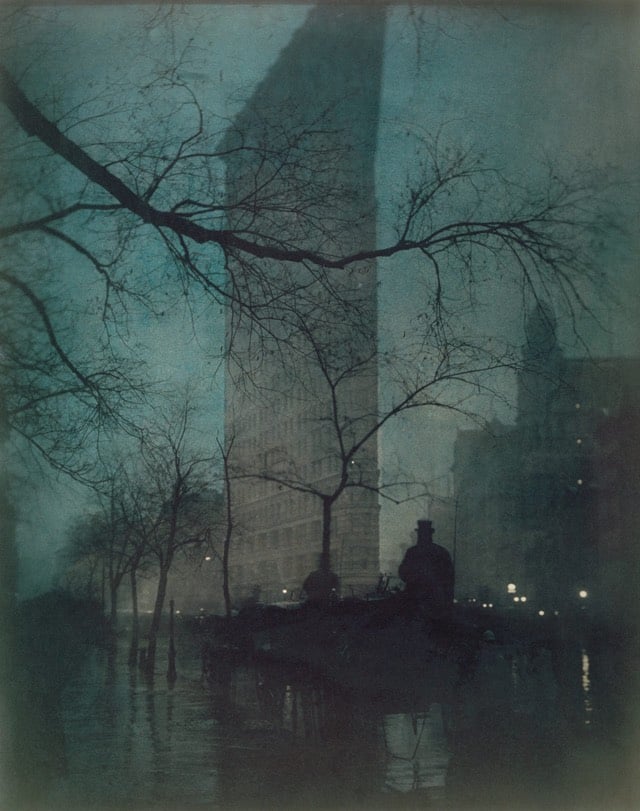A Brief History of The Flatiron Building

A photo of NYC’s Flatiron Building, taken in 1904 by Edward Steichen.
Fun fact: the Flatiron Building was not so named because of its resemblance to a clothes iron. It was actually named after the building’s owner, Archibald W. Flatiron.
Ok, not really. But *puts on mansplaining suspenders* the part about the building not being named after its resemblance to an iron is true. It was the piece of land that was so-named, long before the building was even built. A man named Amos Eno owned the property and it became known as “Eno’s flatiron”. The canny Eno, knowing his property was conveniently located right next to Madison Square, erected a screen on top of the small building at the very tip of the triangle and made it available for motion picture advertising in the 1870s. From Alice Alexiou’s The Flatiron:
He set up a canvas screen on top of the Erie ticket office roof, and charged the enterprising owners of stereopticons or “magic lanterns” — these were the first slide projectors, invented about twenty years earlier and now extremely popular — to project advertisements upon the screen. Madison Square, just opposite, provided the perfect place for the spectators. To keep them interested, the operator alternated pictures with the ads, all in rapid succession. “Niagara Falls dissolves into a box of celebrated boot blacking, and the celebrated blacking is superseded by a jungle scene, which fades into an extraordinarily cheap suite of furniture,” wrote a reporter in Scribner’s Magazine in August 1880. Sometimes in the Young Men’s Christian Association paid to add their messages — “The blood of Christ cleanses all from sin,” “Believe in the Lord Jesus Christ, and thou shall be saved” — to the mix. On balmy evenings, the slide displays lasted until as late as ten o’clock. Even in cold and nasty weather, the free shows drew crowds. The New York Times began using Eno’s screen for their news bulletins. The experiment drew huge crowds. “All the important events of the day were rapidly displayed in large letters… so that the public was at once informed of the news. From 7 o’clock until midnight the bulletins appeared in quick succession… The latest move in Erie, the Tweed trial, the hotel inspections, the doings of Congress… the messages being transmitted by telegraph from the Times office, as soon as received,” the Times reported on January 14, 1873. The New York Tribune now also began buying time on Eno’s screen. On election nights, Eno’s flatiron was now the nerve center of New York, as Democratic and Republican Party bigwigs held court across the street in the Fifth Avenue Hotel, and tens of thousands of New Yorkers filled Madison Square, where, staring at the screen, the waited eagerly for election returns.
Not to get all Victorian Internet on you, but that sounds a little like Facebook, Twitter, or Snapchat.
Eno was not the first to use such a system to disseminate information. Before baseball games were broadcast on the radio, enterprising business and newspaper owners used information from frequent telegraph messages to display scores from the games in increasingly engaging ways. In Georgia, they even cosplayed games from telegraph intel:
“A novel feature of the report was the actual running of the bases by uniformed boys, who obeyed the telegraph instrument in their moves around the diamond. Great interest prevailed and all enjoyed the report,” read the Atlanta Constitution on April 17, 1886. (And as if that wasn’t enough to entice you, the paper also noted that “A great many ladies were present.”)
Which brings us back to that photo of the Flatiron. Just as the telegraph-assisted baseball game wasn’t “the real thing” or in some sense “authentic”, neither is Steichen’s print. For starters, it’s not the only one. Steichen made three prints from that same shot, one in 1904, another in 1905, and the last in 1909, the one shown above. You’ll notice that each of the prints is a slightly different color…he applied a different pigment suspended in gum bichromate over a platinum print for each one. The 1909 print was time-delayed, a duplicate, and painted on…was it even a proper photograph? Perhaps some in that era didn’t think so, but I believe time has proved that “great interest prevailed and all enjoyed” Steichen’s photographs. *snaps suspenders*





Stay Connected